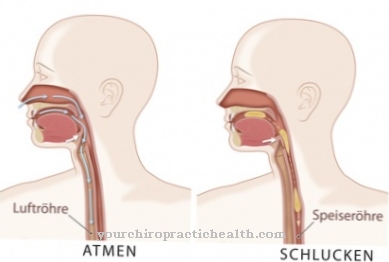The so-called Hatching During embryogenesis, the blastocyst slips out of the glass skin, which encloses it until about the fifth day after conception. This first birth of the offspring is the prerequisite for implantation in the uterus. With in-vitro fertilization, hatching is sometimes done externally by means of a laser.
What is the hatching?

A blastocyst is an early stage in embryogenesis in which a fluid-filled cavity is formed. This cavity is the blastocoel, a trophoblast-enveloped and fluid-filled cavity. This cavity is also known as the bubble germ.
The expression hatching summarizes the processes that allow the bladder germ to hatch in the sense of the blastocyst from the zona pellucida or egg shell. This first hatching takes place around the fifth day after conception and is a condition for the fertilized egg to implant in the uterus.
During hatching, the zona pellucida is burst open by the growth in the sense of an increase in the size of the blastocyst, with germ-induced enzymatic lysis taking place in the sense of cell dissolution. Hatching is followed by implantation, in which the germ is implanted in the mucous membrane of the uterus and can there go into embryonic development.
Often the term hatching is synonymous with the term Blastocyst hatching used. The insemination and formation of the blastocyst are not hatching processes, but are recognized as independent development processes. The blastocyst formation takes place around the fourth day after the insemination and thus around one day before hatching.
Function & task
When the egg is fertilized, a fertilizable sperm penetrates the egg. About four days later, the blastocyst forms from the morula through fluid deposits inwards. The area around the blastocyst is divided into an outer layer of trophoblasts and an inner layer of cells or a cluster of cells made up of embryoblasts. The so-called zona pellucida is located around the blastocyst. The blastocyst initially consists of around 200 pluri-potent stem cells. The blastocystic cells are therefore able to differentiate into any tissue.
The volume of the embryo increases noticeably once a blastocyst cavity has formed in the morula. Towards the end of day five after conception, the steadily growing embryo slips out of its covering layer, the zona pellucida. This hatching is characterized by a sequential series of contractions that cause the envelope to expand. These "expansion contractions" ultimately cause the embryo to explode.
The embryo is supported by enzymes during the detonation. These enzymes dissolve the zona pellucida in the area of the abembryonic pole opposite the embryonic pole. Based on this dissolution, the rhythmic expansion contractions allow the embryo to swell out of the rigid protective cover.
Basically, these processes of hatching are the first birth of the unborn child. After hatching, the polarity of the embryo sets in, which manifests itself in the full development of the embryonic and abembryonic pole. Only the actual embryo can develop from blastomeres within the inner cell mass. The blastomeres from the hollow sphere eventually become the extra-embryonic structures, i.e. the membranes and parts of the placenta.
If hatching is disturbed, a pregnancy in the true sense cannot occur despite fertilization. If there is no hatching, the egg cell remains enclosed by the solid shell of the zona pellucida or glass skin, so that the cells of the embryo can divide within the shell immediately after fertilization without increasing volume, but never leave this stage. If on the fifth day, i.e. in the so-called blastocyst stage, a cavity forms inside the embryo, the child has to leave its rigid shell in order to be able to develop and implant.
Illnesses & ailments
In in vitro fertilization, hatching is partially supported from outside. This assisted hatching or "assisted hatching" is a supportive measure that is supposed to make it easier for the embryo to leave the rigid glass skin. The shell is scored or thinned until the zone bears a defect. So that the embryo does not get stuck when hatching and the hatching process can be completed, the defect must be of a certain size.
Assisted hatching can be done using a laser and thus allows targeted damage to the glass skin. The size and depth of the defect to be made can be precisely adjusted. In order not to injure the embryo, it is held in place with a holding pipette. "Assisted hatching" can also take place with a glass needle. This process corresponds to a partial zona dissection and carries a significantly higher risk of injury to the embryo. As an alternative to these techniques, enzymatic thinning can be used, which makes the embryo shell thinner.
The effectiveness of “assisted hatching” is, however, controversial. Nevertheless, reproductive medicine now speaks of the positive effects of assisted hatching for certain indications. If, for example, microscopic evidence of an above-average thick zona pellucida can be provided, the supportive measure of pregnancy should be helpful.
The same should apply to frozen and thawed embryos. In addition, the IVF measures described are recommended for women over 36 years of age. Most IVF clinics offer "assisted hatching" primarily to women who have previously experienced unsuccessful in vitro fertilization several times.



























